The Empire crew is decked out and ready to dig Psychedelic Wednesdays. Photo courtesy of Michelle Fabry.
Article originally published October 8, 2013 by The Grid online (thegridto.com).
This edition of Denise Benson’s Toronto-nightlife history series tells the story of how a local gay-community landmark was reborn in the late ’80s as a cutting-edge alternative club where you could dance to acid-rock and acid-house alike.
BY: DENISE BENSON
Club: Empire Dancebar, 488A Yonge
Years in operation: 1988-1992
History: In a city where history is so often obliterated or obscured to make way for the new, there’s something comforting about the old clock tower still found atop 484-488 Yonge. It was built in 1870, as part of the original Toronto Fire Hall No. 3, which remained at the address until its move around the corner, to Grosvenor Street, in 1929.
After the hall closed on Yonge, that building was occupied by retail businesses until the St. Charles Tavern took root in 1951. By the early 1960s, the St. Charles was known to be a gay bar. It, along with the nearby Parkside Tavern, became a significant gathering spot that would help hasten the development of queer social life anchored around Yonge during the 1970s. The St. Charles, while also remembered as the focus of homophobic attacks (especially at Halloween), remains one of this city’s best-known gay bars of all time. A number of discos opened above it over the years, with the most popular being The Maygay and Charly’s. A club called Y-Not also operated upstairs in the mid 1980s. By 1987, following years of neglect, the St. Charles was a shadow of its former self and closed.
A year later, the upper level would re-open as Empire Dancebar, a versatile venue dreamed up by friends Dave Craig and Michael Marier. As a teen, Craig had been an MC and DJ in TKO Sound Crew, a popular group that was eventually inducted into the Stylus Awards Hall of Fame in 2008. Craig left TKO to join a new crew, Romantic Sounds, which was started by Marier. Together, they produced events including The House, a weekly underground jam held at the Party Centre at Church and Shuter. As their crowds increased each week, so too did the building manager’s rent demands.
“Eventually Mike’s dad, Bob, suggested that we should get our own space, and he funded the creation of Empire with a quarter-of-a-million dollar investment,” says Craig.
He cites a wide variety of inspirations for the club’s creation, including the house-centric Wednesday nights at The Diamond and Sundays at The Copa, New York’s legendary Paradise Garage, and art galleries in both NYC and T.O. Friend Michele Geister, then a producer at MuchMusic as well as DJ at Tazmanian Ballroom, also introduced Craig to cutting-edge music videos viewed in the Much editing rooms after-hours. This all fed his brain, as did going to check the Taz itself.
“While outside [of the Taz], I saw them turning away tons of good-looking, well-dressed people,” recounts Craig. “I said to myself, ‘I want us to open a club that caters to the people who they are turning away.’ However, on weeknights, I wanted to reach the art crowd, and only the authentic downtown scene, which led us to glam rock and alternative.
“I led the development of the Empire concept and creation of various theme nights, while Mike deserves credit for the awesome sound system, and making the construction happen.”
Empire Dancebar launched November 5, 1988.
Why it was important: Opened at a time when the only busy late-night haunts remaining on Yonge between College and Bloor may well have been the nearby McDonalds and gay dance club Komrads, Empire was a destination spot. With a legal capacity in the area of 600-700 people, it was also spacious—and a bit of a risk as a result.
Craig and Marier chose a dark décor that practically screamed “alternative club!” A long, steep staircase, bathed in black light, led to the second-floor entrance. Empire was a huge, black-and-grey rectangular room with incredibly high ceilings, and signature black-and-white-checkered floor tiles. Its dancefloor was surrounded by industrial chain-link fencing and slightly raised seating areas, complete with round tables upon which staff placed silver ashtrays and red candles.
Bar counters were all a high-gloss black, with the large, main bar located close to windows that overlooked Yonge, while smaller beer bars were placed closer to the club’s rear, along with a pool table, bleachers, and bathrooms. Hallways were painted with murals, many of them in day-glo colours. Local artists were commissioned to create installation pieces while video editors, including early staffers at MuchMusic, crafted custom visuals that played on Empire’s many TV screens. A hundred stick strobe lights placed in the ceiling over the dancefloor would also flash as theatre lights filled the floor with solid colours.
“From the DJ booth, you could control every light in the room, including every TV, and you could go pitch black in the entire venue except for the lights at the cash registers,” recounts Craig. “The effect was very sensual.”
He also remains proud of the system installed by Marier (whom I was unable to reach for comment).
“The 20-speaker Cerwin Vega surround sound system was designed to feel like you were front row at a live show, with a deep heavy bass line.”
“Empire had fantastic sound and lights,” confirms DJ Mark Oliver, an early Thursday resident. “It felt like a lot of time, money, and effort had been invested. Dave and Mike had loads of experience, and it showed.
“Empire was comparable to Twilight Zone in terms of size, but it had a more industrial feel, not just musically speaking. I also loved the DJ booth; it was so spacious, and there was a view of Yonge Street behind it.”
“I was blown away by the sound system,” agrees Jennifer Johnson, a Boom Boom Room and Big Bop staffer who attended Empire’s opening night, and soon after became its star bartender for three years.
“I was in awe of the Empire space. It was huge and open, but still dark and ominous like the Limelight in NYC. It wasn’t in a church, but it was built in [an old fire hall] so it had a cool bell tower, and crazy underground passageways in the bowels of the building that seemed to go on forever. You could feel the history in that building.”
Johnson had followed friend Chris Sheppard to the Empire, just as she had followed the DJ at clubs including Domino, Voodoo, BioRhythm, and The Copa. Sheppard played some Saturdays (“we couldn’t afford Chris every weekend,” Craig admits), but especially helped put Empire on the map with its first New Year’s Eve party, held December 31, 1988.
“At that time, New Year’s Eve was not a big deal downtown; many places offered free admission or only charged $5-to-$10,” recalls Craig. “My feeling was that we should reinvent the way people partied on that night.
“CFNY [now 102.1 the Edge] was at the forefront of live-to-air broadcasts back then. We had the regular-night party with Chris Sheppard followed by the late-night [party] with Deadly Hedley, all broadcast live. The tickets were $50 and sold out within days. End result: After all that media frenzy, Empire Dancebar was packed to the rafters every weekend.”
At its peak, Empire was open six-to-seven nights each week. Much like Twilight Zone, Voodoo and RPM before it, Empire became known as a venue that bridged the worlds of rock, alternative, house and, to a lesser degree, hip-hop.
“The programming was fairly consistent,” says Craig, who hired all of the DJs, developed the theme nights, and headed promotions. “It was alternative during the week, and dance on the weekends, with Psychedelic Wednesdays sandwiched in between.”
Early resident DJs at Empire included duo JohnPaul, CFNY’s Skot (now Scot) Turner, Siobhan O’Flynn, and Terry Kelly. Silver Crown alumni James Stewart held down Saturdays for a stretch.
Craig also credits promoter Michael Holtzman for bringing “glamour and fashion to Thursday nights at Empire, with downtown DJs including Dino & Terry and Mark Oliver.”
“I think Dave and Mike were shocked the first time they heard me play for them,” says Oliver, who came to Empire early in his career, when he was known primarily for playing rare groove and acid jazz at Johnny K’s Krush and Tazmanian Ballroom.
“I had made a name for myself in a very short period of time, but only had one turntable at home and no mixer. All my money went towards buying records, so I learned how to mix in front of a live crowd.
“Empire was the biggest room I had played, and the sound and lights were much more like Twilight Zone than the Ballroom, so I mainly played acid house. Patrick ‘D-Nice’ Hodge from Starsound and myself were the only DJs playing ‘Voodoo Ray‘ at the time, so that was a big one. Todd Terry’s early acid-house anthems were in regular rotation, most notably the massive ‘Can You Party‘ under his Royal House alias.”
Similarly, Paul Azevedo played at Empire early in his career. More recently known as owner of electronic-music specialty store Slinky Music, Azevedo was half of Empire’s Monday-night DJ duo and had a heavy lean toward industrial, alt-rock, and metal.
“I loved Paul’s sincere love and devotion to the music,” shares Iain McPherson a.k.a DJ Iain, a Monday night regular.
“Along with Dave Allen at Voodoo, I consider Paul to be one of the two most fearless DJs I’ve ever heard. I hadn’t heard someone play stuff that was so atypical of club music in a club—like Voivod or Metallica’s ‘One‘—and get away with it. Thus, the people who came out on Mondays were totally into the music, too.”
“What I loved about the Empire was its diversity, and how smoothly Dave Craig transitioned it to make it so all music lovers felt at home,” offers Jennifer Johnson. “Dave had each night carefully planned and organized with a special event, DJ, or cool new theme. We were rammed most nights.”
Perhaps the busiest and best-known night at Empire was Psychedelic Wednesdays. Clearly inspired by the success of RPM’s huge Psychedelic Mondays, Craig developed the theme and promotions, but it was his hiring of Derek Perkins as resident that gave the night its edge.
Perkins was a well-versed rock DJ who’d already played at clubs including The Copa, Klub Max, and the Assoon brothers’ Gotham on Bloor. Siobhan O’Flynn suggested him to Craig, and soon Perkins would play not only Empire’s packed Wednesdays, but also take over O’Flynn’s hard-edged Tuesdays when she returned to school.
From 1990 until Empire’s close, Perkins played rock ranging from Donovan’s “Barabajagel,” Ten Years After’s “I’d Love to Change the World,” and The Doors’ “Peace Frog” to Soundgarden’s “Hands All Over” and Jane’s Addiction’s “Stop,” plus some reggae, house, and more on various nights of the week.
Video: Courtesy of Empire regular Tim Barraball
“The music at Empire was fantastic—especially Derek Perkins,” enthuses Michelle Fabry, a coat-check girl and later bar server who worked at the club for a year. She was 19 at the time.
“All us bar girls would try to get our bar covered and sneak to the dancefloor when a favourite song came on. I remember spending so much time dancing in my own little world.”
She was not as big a fan of the weekend nights.
“The crowds on the weekend tended to be suburban and more rowdy than the downtown crowd that frequented the place during the week,” Fabry says. “Everybody was so chill and relaxed during the week. It felt like a meeting place, comfortable and fun. Many of us would go to Chez Cappuccino after, especially if people had done acid or mushrooms.
“Weekends featured more of a suburban clientele, with more townies and people in-the-know on weeknights,” agrees Craig, who sometimes DJed Saturdays, spinning early house and electro, like “Set It Off,” “House Nation,” “Can You Feel It,” and Lil Louis’ “French Kiss.”
“The overall vibe was fashion without pretense,” he adds. “Empire had the biggest names in entertainment just hanging out, with no entourage, no VIP area, and they paid for their own drinks. [People like] Bruce Willis, Duran Duran, and The Cult would stop by and hang out whenever they were in Toronto.”
“I remember many local music artists, such as BTK, Sloan, and Tea Party, hanging out there,” adds Perkins. “There were lots of CFNY peeps, and staff from other clubs of course.”
Perkins remains particularly fond of his Wednesday regulars.
“The hippie kids that came to Psychedelic Wednesdays really walked the walk—and I mean barefoot! I guess they never saw what the floor looked like with the lights on. Or maybe they were just too stoned to care.”
Empire’s Friday nights tended to bridge crowds, especially with the Manchester music theme that was initially brought to life by CFNY’s Scot Turner, and expanded upon by DJ Iain who took over the night in 1991.
McPherson came to Empire with much experience, having entertained with tight blends of alternative and electronic music at clubs including Nuts & Bolts, The Copa, and Lizard Lounge, which had shut down suddenly.
His audience—and Empire’s—expanded after friend James Kekanovich came on board to help promote Fridays. A Sam The Record Man staffer, Kekanovich would place promo flyers in the CD sections of artists McPherson played, like New Order, Inspiral Carpets, The Farm, Happy Mondays, LFO, Nightmares on Wax, Love and Rockets, and The Chameleons, and diligently handed them out at related concerts.
“We took the attendance on Fridays from approximately 100 people to around 400 within a few months,” states Kekanovich. “The success was based on Iain’s music, and both of us making the time to speak with people who supported what we were doing. Those people became regulars who followed us to other clubs later.”
Some of them also came to Sex on Sundays, a night carried over from Lizard Lounge that found McPherson blending a self-described “typically fucked-up collection of everything from White Zombie and Ministry to Achtung Baby-era U2, electronica like Underworld, Orbital and Prodigy, plus smatterings of festive anomalies thrown in for fun.”
McPherson is keenly aware that he and Kekanovich came on board at Empire during the second half of its lifespan, by which point numbers had dropped and stress ran higher.
“While, at the time, it felt that there was always a simmering pressure to deliver crowds, upon reflection I realize that the owners were surprisingly open to giving unusual formats a chance. It was also a relatively large venue for ‘alternative’ formats at that time, and while Empire was a relatively dark venue, it felt like the club was kept in fairly good repair—at least the DJ booth and gear.
“Being a gear-geek, I loved that, at one point, the layout changed and the DJ booth was moved so that the amp racks were placed right inside the front door, and rose to nearly 10 to 12 feet high. They were the first things you saw when you walked in, and became a signature element of the decor.”
“The bass bins in the centre of the dancefloor made the walls shake,” adds Kekanovich.
Who else played/worked there: Empire Dancebar’s staff tended to be young and bold. Sixteen-year-old punk musician Caitlin Webster greeted customers at the door; 15-year-old high school student Eloisa Negrinni was a main barback, and other bartenders and waitresses who contributed to Empire’s adventurous feel included Angie Coda, Tom Scott, and Erin O’Conner.
“The most special thing about the Empire was the team of people who came together to help make it happen,” says Craig. “The core staff was like the cast of a classic film. Jennifer Johnson wowed with her style and creativity, Eloisa was the most fun, and Caitlin was the coolest.
Johnson is mentioned repeatedly.
“Jen totally stood out,” recaps Fabry. “She worked the main bar, and drew everyone in with her charisma and beauty. I thought she was the coolest girl on the scene—sexy, an awesome dancer, and always with a smile.
“Eloisa was like the hippie flower child dancing to Jane’s Addiction, Caitlin was the sweet little street-smart girl, Margaret was the always-smiling busgirl, while Angie was the sexy, leggy waitress. I was the skinny beer bargirl, with long hair, dyed bright red. We were all so different looking, a real mixed bag.”
“Dave Craig had an amazing eye for the unusual,” offers Johnson. “For example, we were primarily a ‘dance club,’ but our door girl, Caitlin Webster, was beautiful and wee, with the biggest mohawk you ever saw and a big-ass chain hanging from her nose to her ear. I imagine many customers were shocked by her look when they came for the first time, but that was part of Dave’s vision—to shock, turn things upside down, and make you think. It was like a circus wonderland where you never knew what was on the menu that evening.
“The staff would dress in costumes for the themes of the nights,” Johnson continues. “One night, we hung a swing from the ceiling, and I remember being dressed as Alice in Wonderland, sailing over a crowd of hundreds of people dancing to house music. It was magical.” (Johnson left Empire in 1991, and went on to bartend at Bovine Sex Club for 13 years. She is now a professional costume designer.)
Empire’s rooftop was apparently also magical, and held quite the allure.
“I remember a couple who had traveled for hours to come to Empire, but didn’t have ID and couldn’t get in,” describes Craig. “They climbed up on the roof, which was quite a task, and entered the dancefloor through the ceiling.”
Perkins has a very clear recollection from his adventure of climbing the clock tower: “More bird shit I have not seen to this day!”
“The coat check room was under the clock, and there was a secret entrance to the stairway,” Fabry explains. “Once, I climbed up to the clock with Caitlin; it was dark, rickety, and exciting. We could see up and down Yonge.” (Fabry later left Empire for the excitement of a trade desk at Merrill Lynch, and now works in Vancouver’s world of finance.)
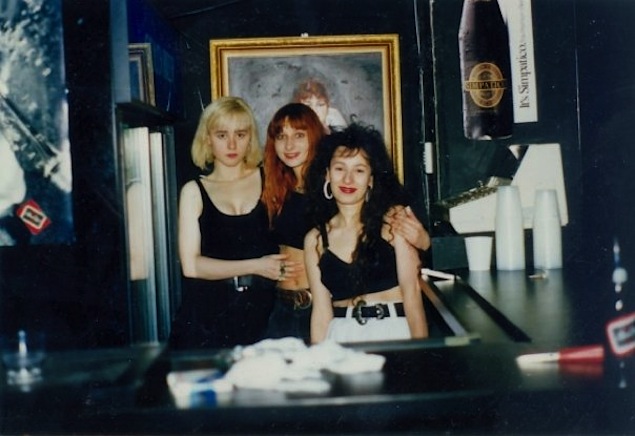
Jennifer Johnson (left) and Michelle Fabry (centre) with a fellow Empire staffer. Photo courtesy of Fabry.
Many of the people I spoke with remarked upon the building’s own history.
“I’m not a superstitious person, but there was chatter amongst the staff that they would see and hear things before the club opened or afterwards,” shares Johnson. “To this day, I believe I felt a ghost behind my bar one night. A freezing cold hand gently touched my waist from behind; I could feel each finger and thumb on my side. When I turned around, there wasn’t anyone there, but it was freezing cold. I called out, and it went away.”
The building’s gay history was celebrated at Empire with the near-two-year-run of B-Bar Sundays, a night promoted by the ever-creative Gilles Belanger and actor/model Steph Watts (now a TV host and reporter living in New York).
Johnson also contributed props and other creative elements to B-Bar while James Vandervoort, a.k.a. DJ James St. Bass, was the night’s original resident. At that time, he was also the DJ behind hugely popular gay men’s nights at clubs including Boom Boom Room and Go-Go, and would soon be found at Limelight and raves including Chemistry.
“By the time of B-Bar, boys had been through many great nights at ‘straight’ clubs, and then at all the warehouses and raves as well,” reminds Vandervoort. “There were a lot of options, and an ever-changing roster of nights and events back then.”
Still, B-Bar was a success, with hundreds soaking up the disco and vocal house played by Vandervoort and, later, DJs including Dave Craig and Mark Baggio.
Vandervoort points to classic tracks like Gwen McRae’s “Keep the Fire Burning” and Juliet Roberts’ “Caught in the Middle,” but one musical moment especially stands out to him.
“I once dropped a remix of Candi Staton’s ‘Young Hearts Run Free’ that caused Gilles to practically birth a litter of kittens in the booth! He had tears of disco joy streaming down his face.”
Other Empire resident DJs included Stephen Scott, who played the special Fetish Night events, Mr. Pete, and DJ Dominik.
What happened to it: By 1992, most of Empire’s original regulars had made their way to other clubs, and the venue had lost a lot of its appeal. Dave Craig left Empire in the later half of that year.
“After a very good run, I felt that it was time to move on to a new chapter,” Craig explains. “Clubs with that dark, underground, alternative look and feel would slowly go out of style. People wanted something new, so one day I just stepped away from it all, and took a year off. Empire closed approximately six months after I left.”
But not before a whole pile of rumours circulated. On Christmas Eve of 1992, Empire had been rented out for a special event. There was a disturbance inside the club, and police were called.
“When the police searched the club, apparently they came across a locked room that contained a pro photocopier and a bunch of paper with prints of currency on one side,” recalls Perkins. “I remember a newscaster saying something like ‘a nightclub owner was hoping for an extra Merry Christmas by printing his own gifts’ or something to that extent.”
“Although this story at the end of Empire’s life cycle went on to become part of its folklore, the charges were withdrawn by the crown at the preliminary hearing,” points out Dave Craig, who went on to help launch the sophisticated, but short-lived Zoo Bar on Queen West, and was a key player at Murray Ball’s hugely successful Whiskey Saigon in the club district. (Craig is now Chief Development Officer of the Marilyn Monroe Café franchise.)
“To this day, I have the upmost respect for those Empire boys,” adds Perkins. “No matter what people think they were doing in those last weeks—I truly have no idea—all I can say is that when the cops closed the doors on that fateful day before Christmas, I thought the records I had locked up there were gone for good.
“Mike unexpectedly showed up a couple of weeks later at my apartment, holding my crates of records and my last paycheque! I can’t tell you how surprised and impressed I was to see him—a stand-up guy in my books.”
Perkins went on to play at clubs including Zoo Bar and Whiskey Saigon, co-founded the popular Freakshow all-ages nights with Michael X, and eventually ran his own “Club Courtesy” after-hours on John north of Queen, and the LIFE Restaurant below. He also opened early digital-recording studio Rhythm Method. (Perkins now lives in Vancouver and works as a marketing director for a national coffee company.)
Like Perkins, Iain McPherson is fairly certain that Empire never re-opened its doors after that Christmas Eve. He and Kekanovich would go on to do nights at clubs including Limelight and Factory (later known as OZ), as well as co-produce the Nitrous raves.
They also did a brief stint at Club Time, which opened at 488 Yonge in late 1993, “but that was a pretty depressing reincarnation of the space,” says McPherson. (Both he and Kekanovich are now instructors at Durham College.)
The upper level at 488 Yonge continued to host clubs, with Time followed by The Tower. Gilles Belanger and others would open it as 488 Yonge a.k.a. Circus in 1995, with signature nights including S.T.U.D. Bar with DJ Scott Cairns on Fridays, and my own S.H.E. Saturdays.
488A Yonge is now home to rental apartments while independent retail outlets, including gear shop Metro Sound & Music, line the street below.
Thank you to participants Dave Craig, Derek Perkins, Iain McPherson, James Kekanovich, James Vandervoort, Jennifer Johnson, Mark Oliver, and Michelle Fabry as well as to Erin O’Connor, Gilles Belanger, and Tim Barraball.

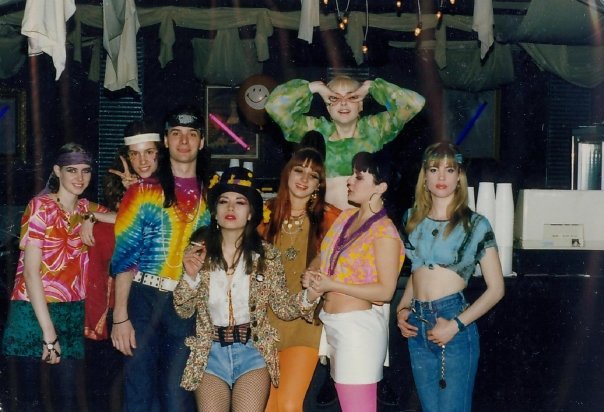
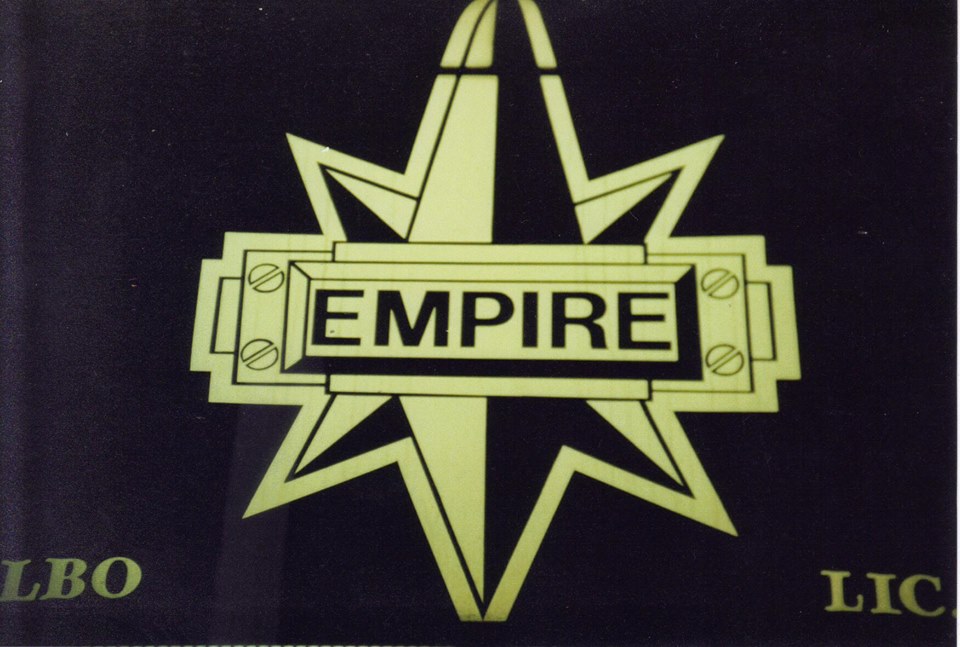
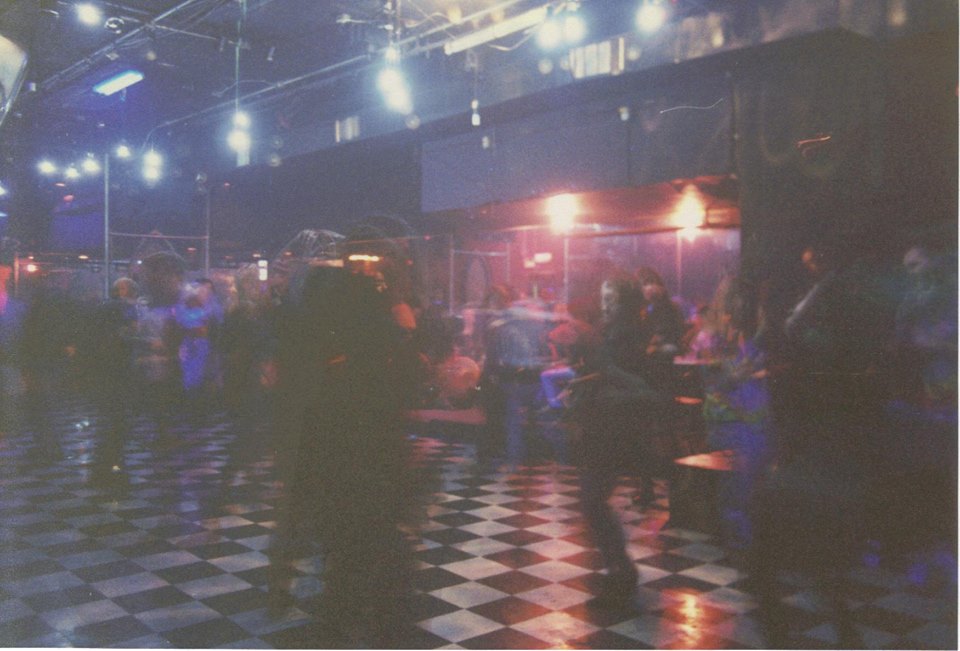
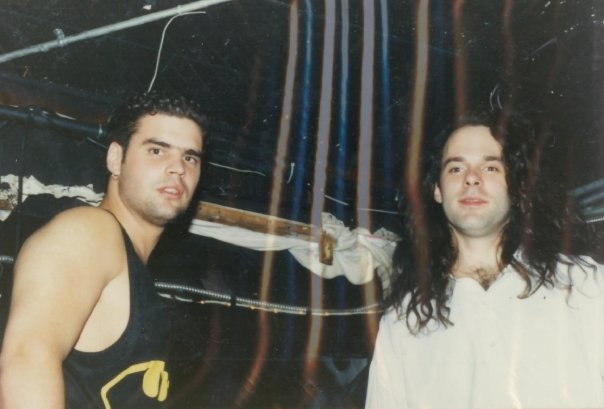
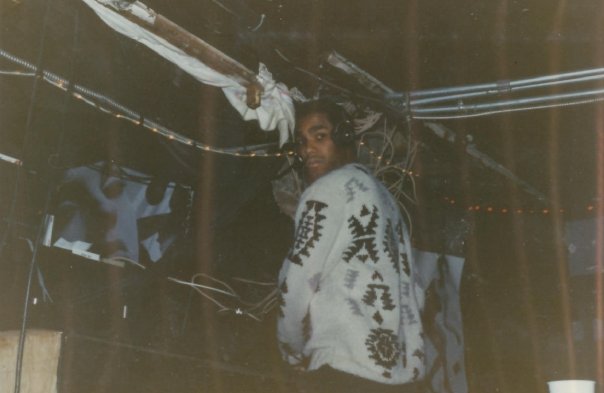

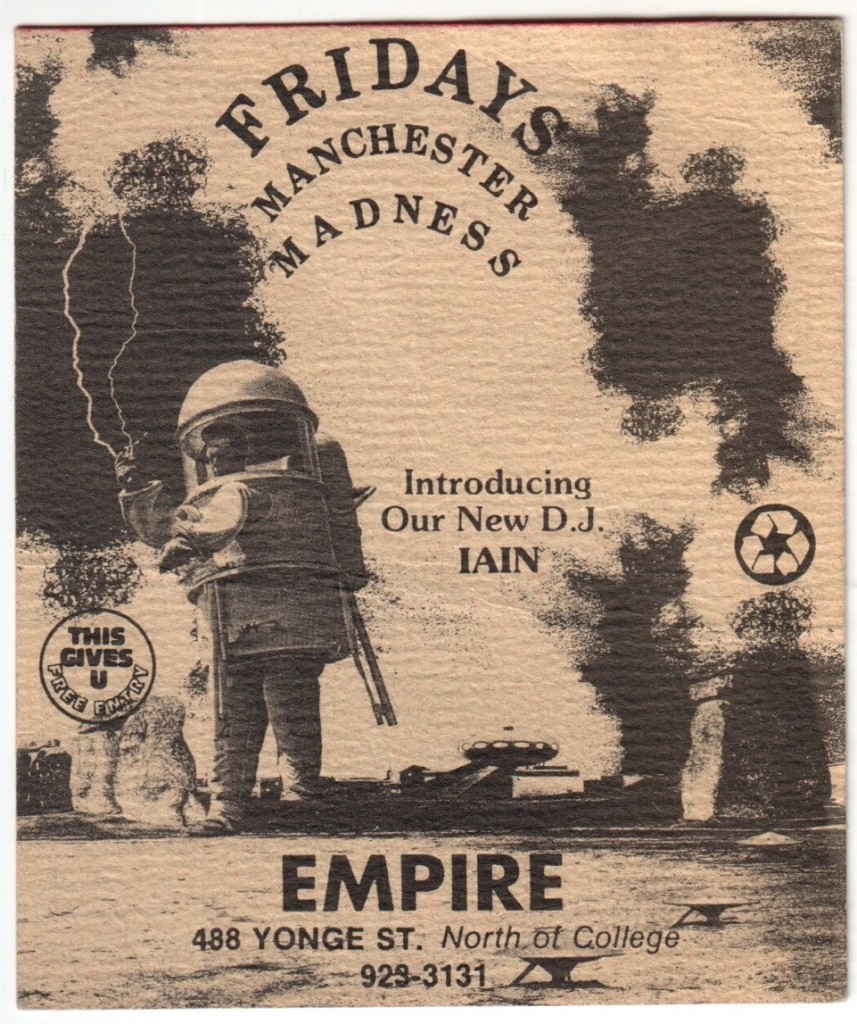
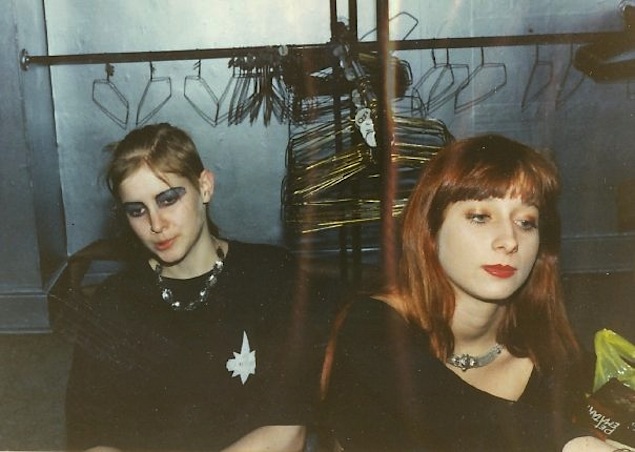
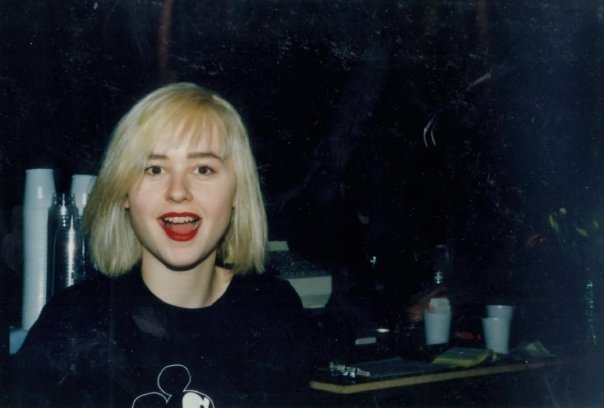
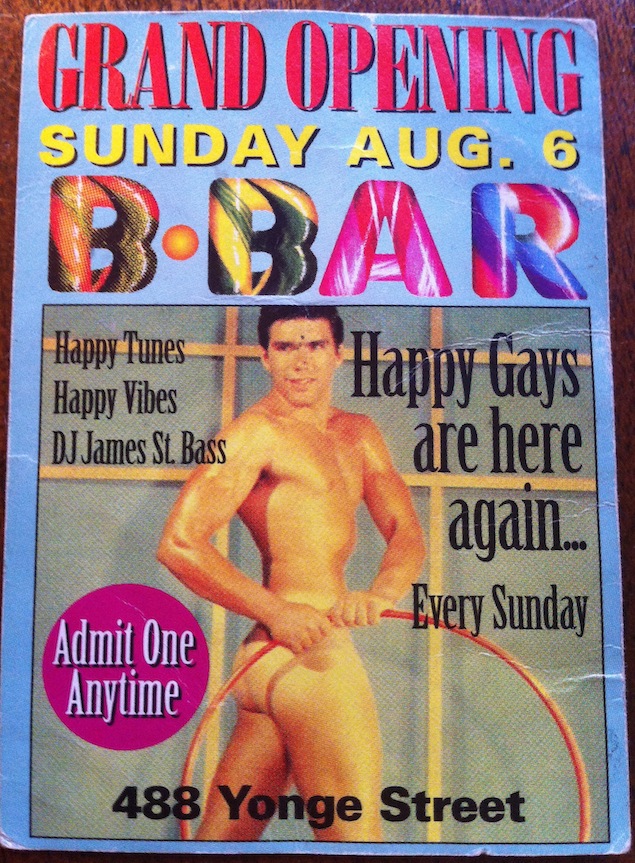
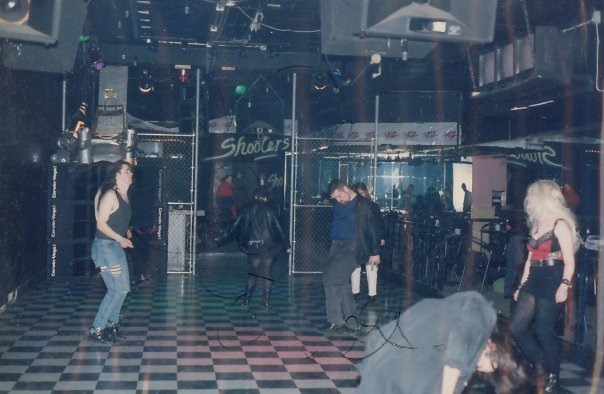
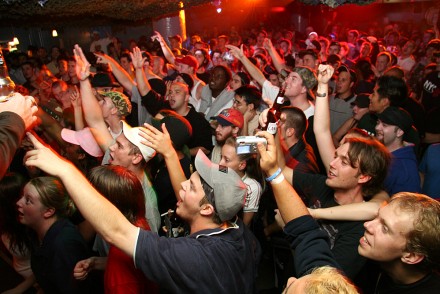
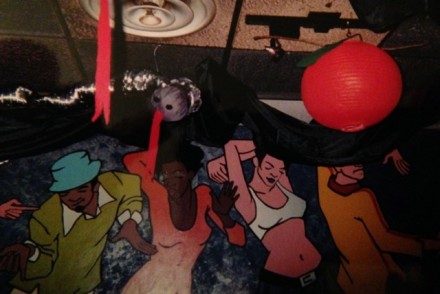
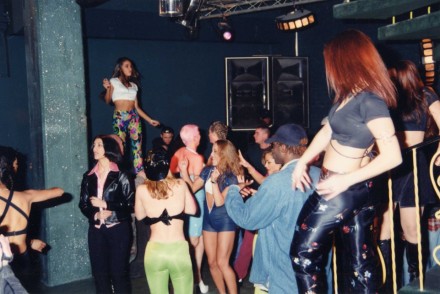

6 Comments
First clubefore I ever went to in 88. Was 16 and had a blast! Got me into dj’ing a couple of years later for a spell.
I worked the door at The Empire for a year and a bit, and I have great fond memories of everyone there. Fellow doorman, Manny, and Caitlin on the bar. Great vide with great owners, super staff, and the best regulars.
For the logest time I was trying to remember where on young it was. I always thought it was closer to wellesley or even above wellesley . I had no clue that were were actually in the clock tower space. Used to go while I was in High school with friends for the Psychedelic Wednesdays, then head back to the burbs taking the after hours bus to get up to go to school in the morning. Music was real hit and miss though…always played that stupid crimson and clover song. On the wednedsts the music was not the greatest. im sure it was better on the weekends. The decor was cool though. it was a hug place, but not enough people people weekdays. too bright too
[…] St. Charles Tavern closed in late 1987. The upper level operated as a succession of clubs, notably Empire Dancebar between 1988 and 1992 . A succession of businesses have occupied the St. Charles Tavern space, while a condo proposal […]
[…] St. Charles Tavern closed in late 1987. The upper level operated as a succession of clubs, notably Empire Dancebar between 1988 and 1992. A succession of businesses have occupied the St. Charles Tavern space, while a condo proposal […]
All comments in the string below have been republished from their original appearance on The Grid website. We’re including the readers’ comments as they add to these Then & Now stories. We look forward to reading new comments here as well.
Manhattan
Wow. What memories! Great article. The music. The girls. The good times. The Empire was my goto night club after I moved to downtown Toronto. I spent many an hour dancing and playing pool there. Really miss those days . . 5:00 pm on July 10, 2014
Hambone
I spent countless hours dancing here..it was truly a magical place in time and space…I went on to become head of security at The Freak Show and floor manager at Life on John..I miss those days and have fond memories of all the people that were involved.
Sandra
Well written piece that brings back many good memories. I was at the first New Years Eve party @ Empire. Met friends that night that I still have to this day. There was always good vibes all around there. 9:14 am on October 9, 2013
Thanks for another great installment!
This continues to be one of the best features i have ever read in a Toronto weekly. Looking forward to the book! 5:06 pm on October 8, 2013
jfurjohnson
We RAWKED> thanks for the memories Denise! 8:35 pm on October 8, 2013